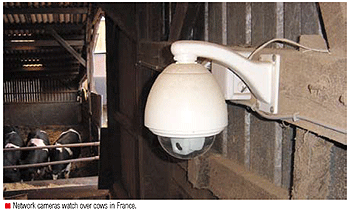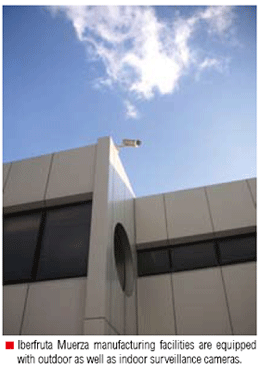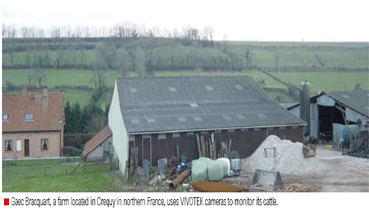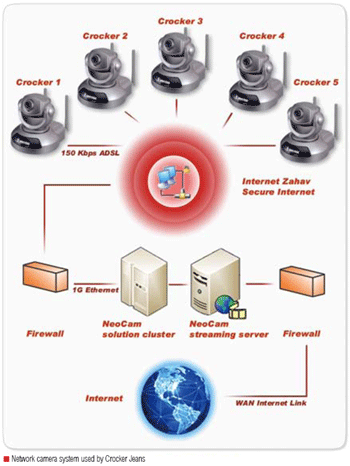Surveillance cameras are used for several purposes in the industry sector, and in several environments, including farms, factories, paper mills and many others.
Surveillance cameras are used for several purposes in the industry sector, and in several environments, including farms, factories, paper mills and many others.

Iberfruta Muerza S.A, in addition to acting as supplier of semi-finished materials for other manufacturers, is also a manufacturer through the trademark BEBE, a company following home-made and traditional methods begun in 1875 and specializing in the manufacturing and marketing of quality marmalade and confectionary, addressed both to the consumer market and the hotel industry.

The proces s of manufactur ing marmalade and preserves gives rise to a series of safety specifications and quality standards for the treatment and preservation of the fruit, where strict control of the product's condition is key. This need to ensure constant control has caused the company BEBE to search for technologies to improve the manufacturing process and quality control of its products. An R&D department was created in order to find state-of-the-art technology for its plant located in San Adrian (Navarra). The need to have a recording of the site's production processes was also part of the requirements, and therefore the search for a system enabling video surveillance tasks with reliable recording and providing added value was started.
On the company's own initiative, two proposals were studied: one based on analog cameras connected to video servers and another fully based on network cameras. The first system studied was the analog one, as it was already partially installed in the facilities for viewing some of the factory's processes. This system presented serious scalability issues as it entailed a significant disbursement of funds every time a camera was to be added to the facilities. Image quality and interlacing problems also raised doubts about this solution.
On the other hand, the IP video surveillance system offered a better solution as to scalability, ease of search for recordings and event management, and image quality. It also gave added value features to the installation, such as video motion detection. The possibility of viewing in real-time, from any PC, what was going on at the factory via a web browser was a significant advantage. This way, the surveillance system would not only turn into a security control tool but would also be a very useful tool for the quality department to monitor processes.
In addition, the ease of integration and the capability to leverage on the existing network induced a lower investment, which was highly appreciated. A first batch of Axis network cameras was installed to cover the parking area of the factory. This experience, given its excellent results, further confirmed the choice of Axis network video technology, pointing out the cameras' superior image quality and the invaluable help of the company's technical support.
The next step was thus to install an IP-based system at BEBE's facilities of San Adrian. A multi-purpose installation was deployed over a broad area, having the following main tasks. Ensure surveillance of the factory's parking area. Obtain a reliable access control of entries and exits from the factory, allowing precise control over access to cold storage rooms, a critical issue for maintaining the product's quality intact. Another requirement was the control of entries and exits of company vehicles. Maintain an optimal process control, monitoring at all times the accumulation of residues in the factory's container area and ensuring, through a visual reference from any point, that the operation of the electric power co-generation plant is appropriate.
Networked Solution
The result has proven to be very positive, both for employees and section supervisors who are able to monitor any of the factory's processes from any PC within the premises. Given the large surface area of the building, a previous installation was found, based on a series of fiber optic points which were satisfactorily used for the new IP installation. This meant an additional benefit as to installation costs.
The advantage offered by Axis network cameras regarding bandwidth consumption, was also appreciated. The possibility of changing the settings of each camera allows the update of the frames per second to be recorded according to the mission performed by each camera at a time.

The business group Iberfruta Muerza S.A., member of the Helios group, is one of the main European manufacturers and suppliers of fruit and vegetable semi-manufactured products. Currently the group owns several manufacturing plants in Spain operating at full capacity, located in Azagra (Navarra), La Palma del Condado (Huelva), and Iscar (Valladolid), as well as other similar facilities in Morocco and Germany.
Promoters of ecological agriculture, the group Iberfruta Muerza S.A. stands out for its responsibility for a product whose end use deserves all kinds of precautions and strict control of each process, from harvesting raw materials to the distribution of its semi-finished or finished products. From the facilities owned by Iberfruta in Azagra (Navarra), the fruit undergoes a peeling, natural processing and preservation process, and from then on, it can be used in several end products: yogurts, baking bases, children's food and marmalade.
Taking Care of Old MacDonald 's Farm
Gaec Bracquart, located in Crequy in northern France, is a farm that houses a herd of 150 cows and provides approximately 600,000 liters of milk each year. The owner of the farm had constantly encountered the need to physically monitor the cows all night, in case the birth cows were in labor. Wanting a way to remotely monitor the herd of cows instead, the farmer sought for a cost-effective solution that would also utilize his existing computer hardware.
The owner contacted Conectis, one of VIVOTEK's distributors, to construct a remote monitoring system with network cameras for the farm. VIVOTEK PZ6122 network cameras were installed in the stable, with the power cord and Ethernet cable lines extended to the farmer's house. The monitoring system, connected to the PZ6122 pan/tilt/zoom network cameras, provides control over the cameras' angular movements and receives superior clear images, even in low light conditions, via real time video transmission.
Remote Monitoring
This solution gives the farmer the ability to conveniently monitor the herd of cows from his home's monitoring system. Without the need to stay in the stable and physically watch over the cows, the farmer saves an innumerable amount of time and energy.
For the farmer, one of the most crucial responsibilities is controlling each step of a birth when a cow is in labor. If a heifer - a young female cow giving birth for the first time - is not rescued from difficult labor, the farmer may easily lose the calf; replacing one would cost up to US$2,750. Thus, the farmer must monitor the birth cows carefully, or he may face dismal consequences. Having installed the VIVOTEK PZ6122 network cameras, which provide a wide range view and real time video transmission, the farmer is now assured he will not miss the birth of a calf. With a reliable and cost effective monitoring system, the owner of the farm is able to control and monitor the herd of cows at ease.
Network Camer as Deliver a Live Show
On another continent altogether, VIVOTEK's solutions offered a different kind of industrial support. Crocker Jeans, a leading Israeli jeans company, wanted to plan a massive, multimillion advertising campaign for its brand, one that would clearly differentiate the company in the jeans industry. Their advertisement agency suggested a bold strategy: to allow shoppers to display their new look in Crocker Jeans' apparel to their friends over the internet. With the decision to attempt such a campaign, the company looked for a solution that would make the idea possible.

Neo IT, one of VIVOTEK's distributors in Israel, provided the innovative software technology called NeoCam, collaborating with Internet Zahav, the leading Internet service provider in Israel, which provided the network infrastructure. Combined, Crocker Jeans Intl. was introduced with a high level yet cost-effective solution via an IP-based surveillance system; In addition, not only does the system present a unique method of communication, it also provides real-time, user-friendly and cost-effective security for the retail stores.
NeoCam is a next-generation web-based application for viewing, monitoring and managing, using real-time video distribution over the internet, allowing the freedom to logon anywhere, anytime, from any internet browser. NeoCam is turning security and video distribution services to a commodity accessible for all types of customers, using the familiar method of low monthly service costs like one has today with its internet or cellular provider.
For the Crocker project, NeoCam used VIVOTEK PT3127 high-performance network cameras that were installed outside the shops' fitting rooms. The intent is to give shoppers the ability to communicate with their friends. Through the network cameras, shoppers can reveal their new fashion apparel; their friends, receiving live videos through web browsers, can then give real-time suggestions.
Attraction for Youngsters
The interesting facility serves as a stage for youngsters to pose and flaunt their new appearance in front of their friends, satisfying both the buyer's vanity and the viewer's curiosity. Crocker Jeans Intl served more than 50,000 unique viewers during the first week of its campaign launch, giving its shops and brand name impressive exposure. This innovative way of interacting with peers has successfully attracted many young shoppers to step into Crocker Jeans Intl stores.
With a central monitoring system linked to about 30 network cameras throughout its branch stores in Israel, Crocker Jeans Intl has been able to construct a security solution to protect its goods and prevent theft in the retail stores, while at the same time gaining pleased customers.
Process Monitoring in the Paper Industry
There will always be paper. Despite the digital, or so-called "paperless" age, the paper industry is still booming in Germany. This means that bleached long-fiber cellulose, which is used to produce fine and printing paper as well as high-quality sanitary paper, also remains very much in demand.
The high demand induced Mercer International, an American-Canadian pulp and paper manufacturing company, to set up a new cellulose plant in the north of the German state of Saxony- Anhalt. Naturally, the good infrastructure and the favorable location in Central Europe were also important prerequisites to warrant an investment of a total $1,4 billion. In addition, some 580 new jobs were created, making the modern plant, which started its production in the summer of 2004, the largest employer in the region.
On business premises close to 200 acres in size, Zellstoff Stendal processes about two million solid cubic meters of log wood and one million solid cubic meters of wood chips to obtain 570,000 tons of cellulose each year. The log wood is debarked in the direction of the fiber, chopped up and cooked using heat and chemicals in a pulping process. The resulting pulp is then washed, sorted, bleached, drained, dried and shaped. In the so-called leaching line, the chemicals used are recovered and returned back into the production process.
The entire production process is sustainable and environmentally friendly. In Germany, for example, more wood grows than is harvested. The extraction liquid and the sludge that are produced during the CO2-neutral burning of the scrap wood, cover not only the plant's relatively high energy consumption (55 MW), but they also feed another 35 MW into the public power network. To reliably monitor the cellulose production process, Zellstoff Stendal uses a total of 58 Mobotix cameras.
Too Dangerous
"Many areas in the production plant are too loud, too warm or too dangerous for our employees. But production in these areas still has to be carefully monitored," said Kay Heppner, System Manager at Zellstoff Stendal, explaining the reason for the relatively large number of surveillance cameras in operation. That is why the Magdeburg branch of Siemens AG was already commissioned to prepare a comprehensive communications concept for a data network during the project planning phase. The concept was to be designed not only to accommodate data and voice/telephony services, but also for the transmission of images, which would then be directly displayed in the production control rooms.

"We need these images live and in good quality to guarantee optimum monitoring," continued Heppner. "After all, without a properly functioning camera system, we would not be able to run the production lines. A camera malfunction would automatically mean production downtime at our plant."
Providing good-quality images live used to be a task that was generally performed by analog video technology. "But that would have meant an awful lot of complicated wiring," said graduate Engineer Axel Borchers with a frown. As the network expert at Siemens AG in Magdeburg, Borchers was in charge of preparing the communications concept and supervising the project. "For the digital 'data' and 'voice' services, we had planned to use a fiberglass/copper network to connect all 25 buildings on the extensive premises. To provide analog video technology, we would have also had the complicated task of laying another cable along with installing the cross bars required and the corresponding monitors." This was enough reason to start thinking about whether or not there was an IP camera that had a frame rate able to do the job and that could easily be hooked up to the already-planned digital network.
"In the past, we had already had very good experience with network cameras from MOBOTIX. The tests we then performed indicated that these cameras offered the image quality we needed, thus meeting all the necessary requirements. That's why we recommended this technology in our communications concept," commented Borchers.
"Of course, at the same time, we looked at a number of different systems and discovered that, in terms of quality and expansion options, MOBOTIX offered the best system overall," added Heppner. "The camera does not have any mechanical parts and it is extremely robust. In addition, it has no problems with fluctuations in temperature and is able to deal easily with different degrees of brightness as well as backlight. In short: many of the details and features it is equipped with are also things that we urgently needed to monitor our production processes."
At Every Location
The system manager is also enthusiastic about the camera's flexibility: "I can connect the camera to any point in the network and make the image it records available to any other point with a normal PC or notebook. In the control room, the camera images can be easily switched to another monitor. Servicing and maintenance are also hardly needed. Besides, I can even log on at home to alter the configuration of a camera or change other settings."
Although a total of three services at Zellstoff Stendal GmbH are now routed via a data line, there have been no adverse effects on system performance. Measurements have shown that the network load of the communications network is exceptionally low even when video images are being transmitted, something which can surely be attributed to the amply dimensioned 100 MB (copper) or 1 GB (fiberglass) lines as well as to the fact, that despite its high performance, MOBOTIX technology requires only an extremely low data rate.
It looks as though Siemens would like to continue working with this system. An Italian company is currently in the process of building a new paper factory directly in the vicinity of Zellstoff Stendal GmbH, and its communications network is being designed by the Siemens branch in Magdeburg. As far as Axel Borchers is concerned, MOBOTIX cameras will be used for monitoring production processes in this new project as well.